Sea turtles are beautifully adapted to life in the ocean. They have streamlined shells and flippers that support efficient, hydrodynamic swimming. However, while they are graceful swimmers, they don’t tend to be, like their terrestrial relatives, particularly fast movers.
However, can they fly through the water when they need to? And if so, just how fast can they move when they are threatened or chasing prey?
In this guide, we’ll cover the estimated top speeds of sea turtles as well as provide some interesting facts about each species of marine turtle. Read on to learn more.
Taxonomical Classification, Origin, and Distribution of Sea Turtles
Sea turtles, also called marine turtles, belong to the Testudines order of reptiles and the suborder Cryptodira. The order Testudines contains all turtles and tortoises. The suborder Cryptodira contains all freshwater turtles, snapping turtles, tortoises, soft-shelled turtles, and sea turtles.
Currently, seven species of sea turtles are classified into two families. The Chelonioidea, which contains six of the seven species, and the Dermochelyidae family which contains the scute-less leatherback turtle (Dermochelys coriacea).
The six species that belong to the Chelonioidea family all contain scutes on their shell, which are horned plates. These six species are as follows:
- Loggerhead (Caretta caretta)
- Kemp’s ridley (Lepidochelys kempii)
- Olive ridley (Lepidochelys olivacea)
- Hawksbill (Eretmochelys imbricate)
- Flatback (Natator depressus)
- Green sea turtle (Chelonia mydas)
Origin of Sea Turtles
From studying the fossil record, scientists recognize the earliest known sea turtle as appearing in the Early Cretaceous period around 110 million years ago. These marine turtles likely are descendants of marsh-inhabiting ancestors of the Triassic who existed about 200-250 million years ago.
Distribution of Modern Sea Turtles
Currently, various species of sea turtles live worldwide in tropical, subtropical, and temperate regions of almost every ocean basin around the world. They tend to primarily live in shallow, coastal waters, lagoons, estuaries, bays, and around reefs. Most species also occasionally journey into the open oceans, especially when undergoing off-shore migration travels.
Endangered Status
Currently, all sea turtle species face some level of population vulnerability with the majority of species considered endangered across much of their native range. The primary threats to many populations of sea turtles include the following:
- Fishing bycatch
- Poaching of eggs
- Killing of turtles
- Loss and destruction of nesting sites
- Ocean pollution
- Ingestion of artificial debris
- Entanglement in fishing nets
- Climate change
How Fast Can Sea Turtles Swim?
Sea turtles are graceful, elegant swimmers, and watching them gently cruise through a reef habitat is simply awe-inspiring. While sea turtles tend to swim along at energy-conserving speeds, they will occasionally quickly glide through the water, often as a startle response. So, just how fast can these beautiful creatures swim?
Well, studies overwhelmingly document the average cruising speed of sea turtles rather than their occasional burst speeds. For six of the seven species below, we’ll provide studies that have documented these cruising speeds, which are similar among species. Regarding their burst speeds, there are currently no publicly available studies that document these fast movements. However, according to the Smithsonian and MarineBio Conservation Society, the top speeds of sea turtles average about 15-22 mph, with some sea turtle conservation and research groups pointing to the green sea turtle and the leatherback sea turtle as the fastest swimmers.
How Fast Can Sea Turtles Swim: Leatherback Sea Turtle (Dermochelys coriacea)
The leatherback sea turtle (Dermochelys coriacea) is classified in its own family, Dermochelyidae. This is primarily due to its lack of scutes, or horny plates, along the upper portion of its shell (carapace). Instead, the leatherback turtle has a soft, flexible shell, adapted to allow it to dive to great depths in search of prey. Currently, the deepest recorded dive of a leatherback turtle is nearly 4,000 feet.
Leatherbacks are omnivorous and prey on a variety of sea animals including squid, fish, crustaceans, jellyfish, and tunicates. They also will feed on algae and seaweed. They dive to such great depths primarily to hunt jellyfish and squid. Compared to other species of sea turtles, the leatherback spends significant time in the open ocean.
The leatherback sea turtle is the largest species of marine turtle, reaching up to 7 feet long and weighing up to 1,500 pounds. This species also has the widest global distribution of any reptile. They are highly migratory animals. Researchers have recorded some individuals swimming over 10,000 miles per year between their nesting and feeding grounds.
While they were once abundant in every tropical, subtropical, and temperate ocean, these beautiful animals are now endangered. The populations of Pacific leatherback turtles are the most critically endangered of the species.
According to a study on the swimming speeds of 7 female leatherback sea turtles off the US Virgin Islands, the average cruising swim speed of this species was 1.25-1.88 miles per hour.
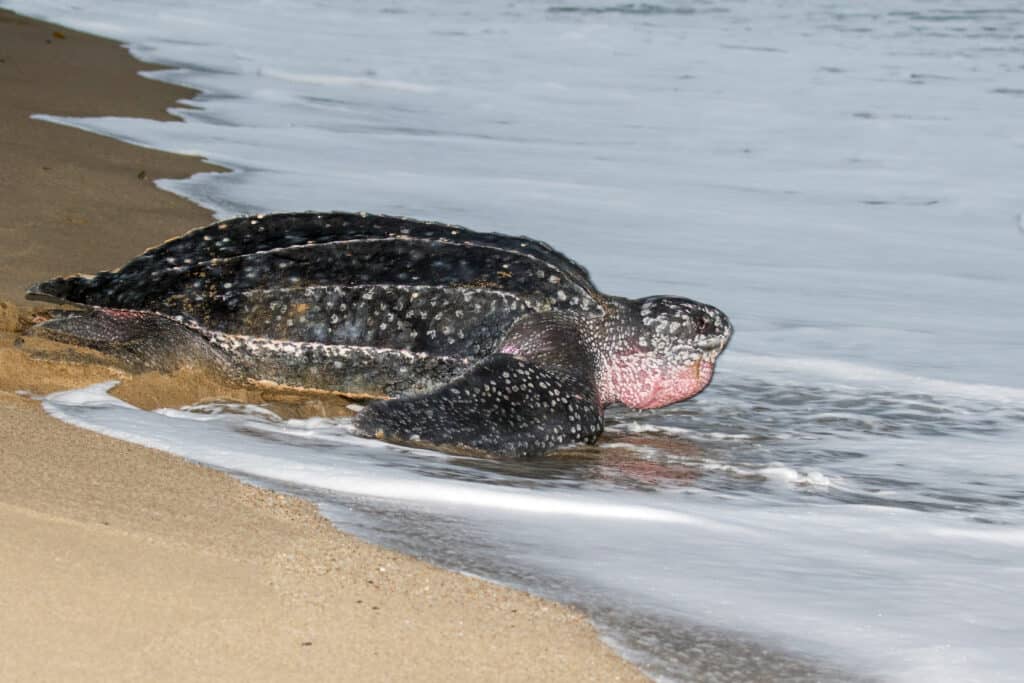
Leatherback sea turtles are the largest species of marine turtle. They are also perhaps the fastest swimmers.
©iStock.com/AGAMI stock
How Fast Can Sea Turtles Swim: Green Sea Turtle (Chelonia mydas)
The green sea turtle (Chelonia mydas) is sadly currently endangered or threatened across most of its range. This is due to bycatch in fishing equipment, loss and destruction of nesting habitats, harvesting of turtles and their eggs, strikes by watercraft, climate change, disease, and ocean pollution.
This species is unique among sea turtles as it is a primarily herbivorous animal. They eat mostly seagrasses and algae. Less often, green sea turtles will feed on sponges, invertebrates, and fish carcasses. The Eastern Pacific green turtles (sometimes considered a subspecies- Chelonia mydas agassizii) feed on these animals more than other populations.
According to a study researching the mechanics and efficiency of sea turtle movements, green sea turtles cruise through the ocean at average speeds of .6-1.1 miles per hour. Since they don’t typically predate on quick-moving animals, green sea turtles usually only swim in fast bursts to try to evade a predator or in reaction to a startling disturbance.
Green sea turtles have a particularly strong adaptation for staying underwater for long periods of time. They can stay submerged for up to 5 hours before needing to surface to breathe. This is in part due to their extremely slow metabolism and the ability of their heart rate to slow to one beat every 9 minutes.
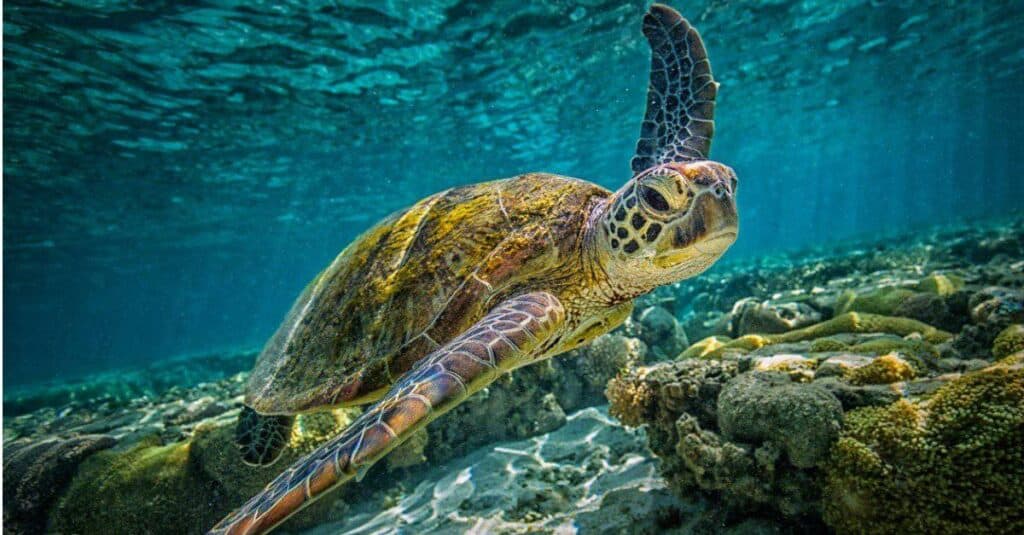
Green sea turtles are a primarily herbivorous species.
©iStock.com/Greg Sullavan
Loggerhead (Caretta caretta)
The loggerhead sea turtle (Caretta caretta) is an adaptable species that can inhabit the coastal waters of all continents except Antarctica. This species is also threatened or endangered across most of its range.
The common name is in reference to its large head and powerful jaw muscles adapted for catching and feeding on hard-shelled prey such as whelks and conch. Hatchlings and juveniles spend the first 7-15 years of their lives in the open ocean before returning to coastal waterways. These impressive animals can migrate thousands of miles over the course of their 80+ year lives between feeding areas and nesting beaches.
Loggerheads are primarily carnivorous with their diet consisting mostly of crabs, mollusks, and whelks. These species are typically slow swimmers as their prey aren’t usually fast-moving. One study tracking the transatlantic migration of juvenile loggerhead sea turtles found that their average cruising speed was a little under 1 mile per hour.
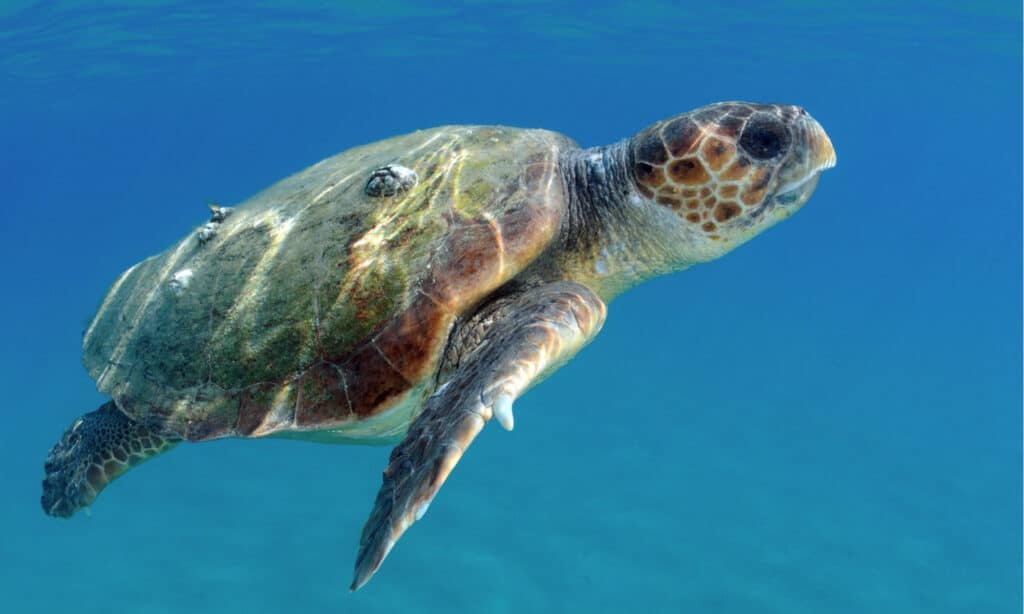
Loggerhead sea turtles have powerful jaws for catching hard-shelled prey.
©Matteo photos/Shutterstock.com
Kemp’s Ridley Sea Turtle (Lepidochelys kempii)
The Kemp’s ridley sea turtle (Lepidochelys kempii) is the smallest marine turtle in the world and has the most restricted range. It is also critically endangered across its limited range from the Gulf of Mexico to the coastal waters of the northeast US. In the 1980s, researchers documented only about 200 females across its range nesting on beaches. Today, thanks to conservation efforts, their population has increased to 7,000-9,000 individuals.
These sea turtles may also live shorter lifespans than other species. Currently, researchers know that they live at least 30 years. They reach reproductive maturity between 10-15 years of age, which is much younger than other marine turtle species. As the smallest species of marine turtle, adults typically reach about 2 feet long and weigh up to 100 pounds.
This species tends to stay near coastal waters where they hunt for crabs, fish, jellyfish, shrimp, sea urchins, and a range of mollusks.
One 1995 study found that their average cruising speed ranges from .4-.8 miles per hour.
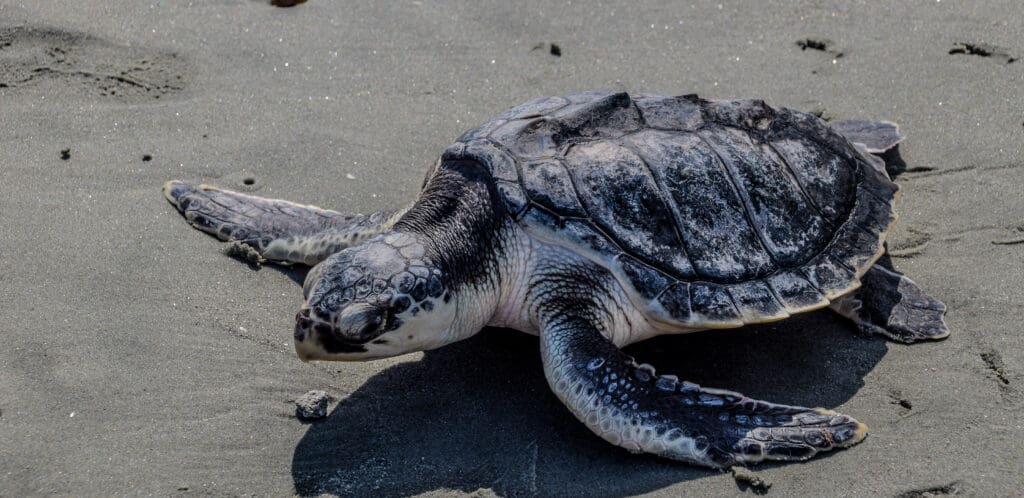
The Kemp’s ridley sea turtle is the smallest marine turtle species in the world.
©Prentiss Findlay/Shutterstock.com
Olive Ridley Sea Turtle (Lepidochelys olivacea)
Sharing the Lepidochelys genus with Kemp’s ridley turtle is the olive ridley sea turtle (Lepidochelys olivacea). The olive ridley, so-named for its olive-green shell color, is also known as the Pacific ridley sea turtle. Unlike the Kemp’s ridley sea turtle, the olive ridley turtle’s range includes tropical and subtropical waters of the Pacific, Indian, and Atlantic Oceans.
This species is omnivorous and has powerful jaws that enable the olive ridley turtle to feed on mollusks, shrimp, crabs, and tunicates. They primarily live in coastal bays and estuaries but the olive ridley turtle can also make oceanic voyages as part of its migration patterns. They can dive to depths of 500 feet and feed on bottom-dwelling crustaceans.
Currently, the International Union for Conservation of Nature and Natural Resources lists the olive ridley sea turtle as vulnerable.
One study of the cruising speeds of olive ridleys found that these turtles tend to swim at about .5 mph.
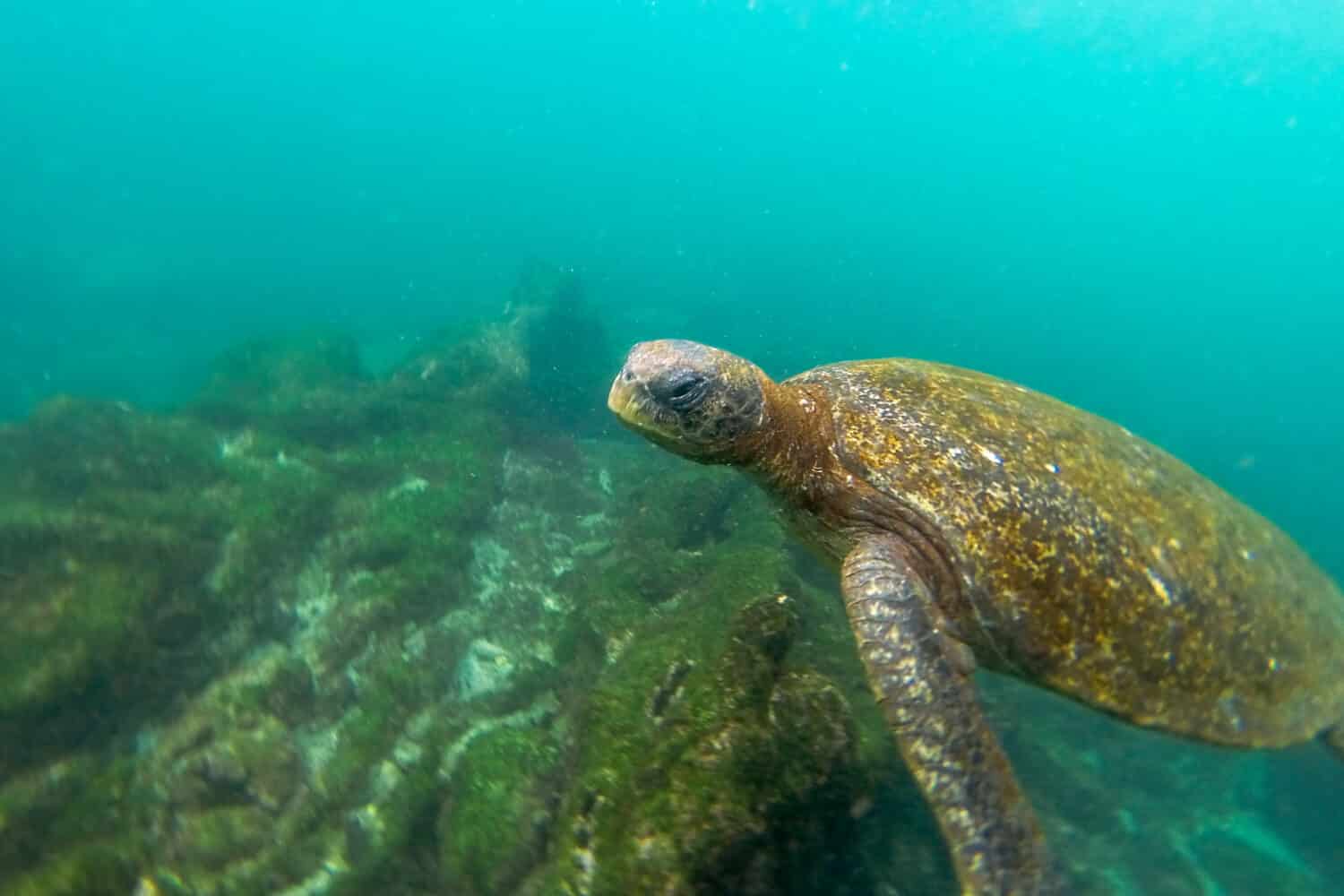
The olive ridley sea turtle tends to cruise along at about .5 mph.
©Structured Vision/Shutterstock.com
Hawksbill Sea Turtle (Eretmochelys imbricate)
The lovely hawksbill sea turtles (Eretmochelys imbricate) live throughout the tropical and subtropical waters of all the major oceans. This sea turtle features a uniquely beak-like mouth that enables it to efficiently find food in difficult-to-reach areas of coral reefs. The primary food source of the hawksbill sea turtle is sponges. As such, this species tends to live primarily in and around coral reefs.
As an adult, this smaller sea turtle grows to about 2-3.5 feet in length and can weigh up to 150 pounds. Likely, this species of sea turtle can live at least 50 years.
Like other sea turtles, human-caused threats endanger the hawksbill throughout much of its range. Currently, this species is most abundant in the Caribbean Sea and Indian and Indo-Pacific Oceans.
These regions are also popular nesting locations. Annually, about 6,000-8,000 hawksbill sea turtles nest on remote beaches near the Great Barrier Reef, located off the coast of Queensland, Australia.
A study of hawksbill sea turtle hatchlings found that their average swim speed was about .5 mph. Likely, the average cruising speed of adults ranges between .5-1.5 mph.
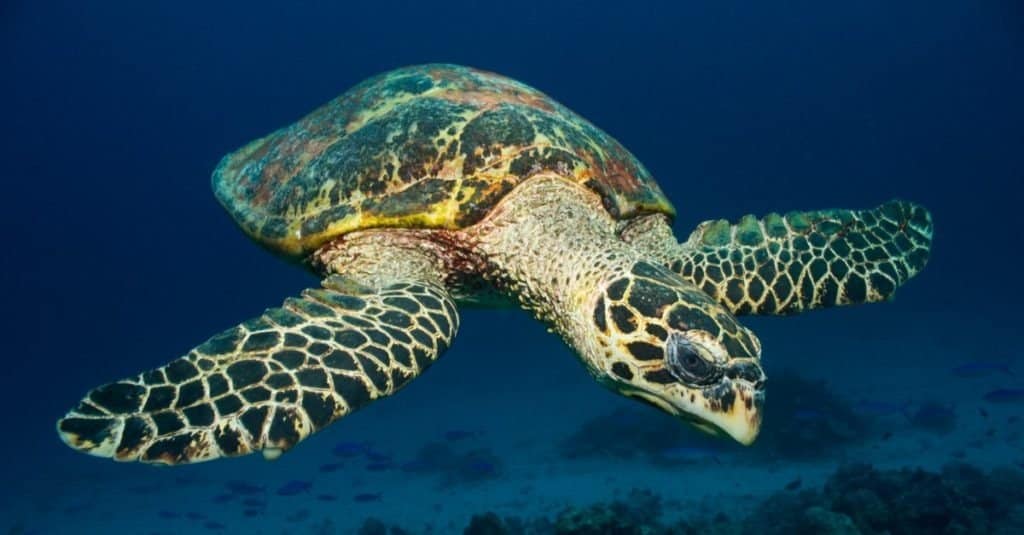
The hawksbill sea turtle has an especially defined beak-like mouth perfect for foraging in hard-to-reach places.
©John Back/Shutterstock.com
Flatback Sea Turtle (Natator depressus)
The flatback sea turtle (Natator depressus) is so named for its carapace (upper shell) which does not display any ridges as is common in other sea turtle species. While this species is medium-sized, they are significantly larger as hatchlings than other marine turtles except for leatherbacks.
This turtle’s range is limited to the coastal and near-coastal waters around Australia and Papua New Guinea. Adults grow up to about 3.25 feet long and can weigh up to 200 pounds. These coastal-living marine turtles enjoy a varied diet of sea cucumbers, mollusks, sponges, jellyfish, prawns, seaweed, and other marine invertebrates.
The flatback sea turtle is currently listed as vulnerable under the Australian Environment Protection and Biodiversity Conservation Act. Currently, researchers estimate there are about 20,000 nesting females left in their native range.
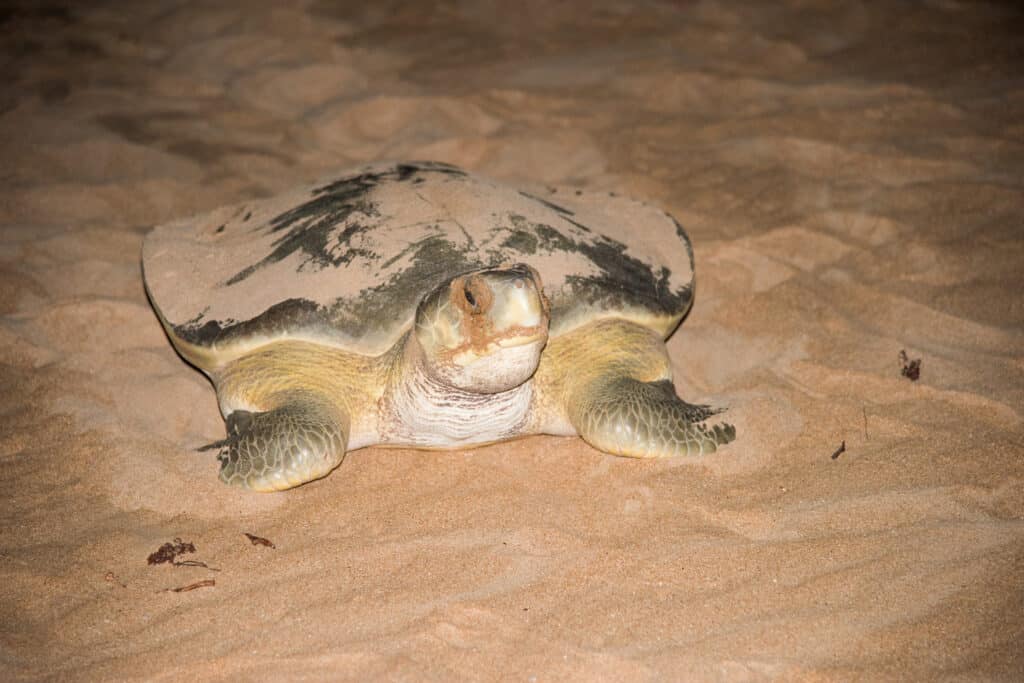
Researchers currently estimate that there are about 20,000 nesting female flatback turtles left in their range.
©iStock.com/EAGiven
The photo featured at the top of this post is © iStock.com/naturepics_li
Thank you for reading! Have some feedback for us? Contact the AZ Animals editorial team.







